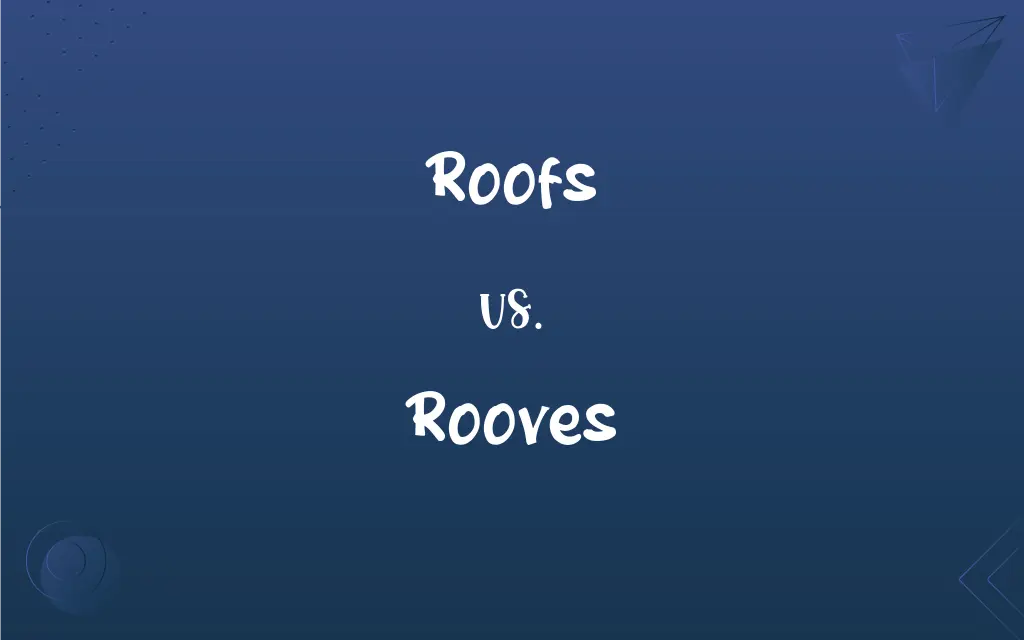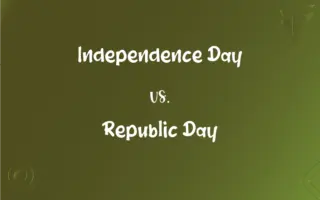Roofs vs. Rooves: What's the Difference?
Edited by Janet White || By Harlon Moss || Updated on October 11, 2023
"Roofs" is the standard plural form of "roof" in modern English, while "rooves" is an archaic and now rarely used variant.

Key Differences
"Roofs" substantiates its position as the widely accepted and conventionally utilized plural form of the noun "roof". When referring to more than one roof, grammatical norms and general conversational and written English most commonly deploy "roofs". Whether discussing various styles, structures, or multiple buildings, the term "roofs" seamlessly finds its place in modern linguistic applications, for instance, in discussing the diverse "roofs" of a cityscape.
Contrastingly, "rooves" parades as an old-fashioned and predominantly obsolete variant for the plural form of "roof". Historically, "rooves" was an acceptable form and was used in English literature and documents. Today, though, it is notably sparse in usage and largely recognized as archaic, while "roofs" proudly heralds standard practice in both American and British English, making "rooves" a rare encounter in contemporary writings and dialogues.
The adaptation of "roofs" as the prevalent form subtly underscores the evolution and streamlining of the English language. Linguistic patterns, particularly in English, naturally morph and adapt to communal usage and simplicity. Thus, "roofs" not only stands as a testament to a linguistic adaptation but also to linguistic efficiency in modern vernacular.
In particular contexts, historical or otherwise, one may stumble upon "rooves" either as a stylistic choice or in period writings. Some older texts or those wishing to instill a sense of antiquity may opt for "rooves" as a nod to historical English, although the standardization of "roofs" in modern dictionaries and language guides distinctly earmarks "rooves" as an outlier, infrequently sighted in modern prose.
"Roofs" and "rooves", though divergent in their contemporary applicability, both pivot around the same semantic point, referring to the plural form of the top covering of a building. The dichotomy essentially boils down to a reflection of linguistic transformation, with "roofs" manifesting as the contemporary, widely acknowledged term, while "rooves" lingers primarily in the annals of linguistic history.
ADVERTISEMENT
Comparison Chart
Modern Usage
Predominantly used in current English.
Rarely used in modern contexts.
Historical Usage
Has been used historically but is also modern.
Used in older forms of English and historical documents.
Recognition in Dictionaries
Recognized as the standard plural form.
Typically noted as archaic or obsolete.
Linguistic Preference
Preferred in both American and British English.
Generally not preferred in any variant of English.
Grammatical Correctness
Considered grammatically correct.
Not considered incorrect but is notably outdated.
ADVERTISEMENT
Roofs and Rooves Definitions
Roofs
Roofs often encapsulate various materials and architectural styles.
Tourists marveled at the ornate roofs of the historic temples.
Rooves
"Rooves" implies multiple upper covering structures of buildings in old English usage.
The rooves were adorned with intricate carvings and motifs.
Roofs
Roofs are designed to offer protection against weather elements.
The roofs were designed to withstand heavy snowfall.
Rooves
"Rooves" serves as an archaic plural form of "roof".
The village had quaint houses with thatched rooves.
Roofs
Roofs can metaphorically represent a protective or limiting overhead presence.
After years of strict governance, they were finally free from oppressive roofs.
Rooves
"Rooves" can be synonymous with multiple tops of buildings in some historical texts.
The rooves of medieval cottages were commonly made from straw.
Roofs
Roofs refer to the plural form of the top covering structure of buildings.
The town has houses with brightly colored roofs.
Rooves
"Rooves" might be utilized to refer to various protective shelters in antiquated contexts.
The settlers built rooves using local timber and foliage.
Roofs
Roofs symbolize the upper exterior surfaces of structures, providing shelter.
The ancient ruins reveal a variety of roofs constructed by early civilizations.
Rooves
"Rooves" can be seen in certain regional dialects or poetic expressions to imply multiple roofs.
Beneath the rooves of the old town, myriad stories unfolded.
Rooves
Plural of roof
FAQs
Can "rooves" be used in contemporary writing?
It can be used, but it is considered archaic and might be seen as a stylistic or deliberate choice.
Is "rooves" a misspelling of "roofs"?
No, "rooves" is an archaic and rarely used plural form of "roof".
Does "roofs" have any metaphorical meanings?
Yes, "roofs" can metaphorically represent shelter or protection.
Why might a writer choose to use "rooves" instead of "roofs"?
A writer might use "rooves" for stylistic reasons, to convey a historical or antiquated tone.
What does "roofs" mean?
"Roofs" is the standard modern plural form of "roof", referring to the top coverings of buildings.
Which term is more commonly used: roofs or rooves?
"Roofs" is significantly more commonly used in modern English.
Does "rooves" appear in any notable literature or texts?
"Rooves" might appear in older literature, reflecting past usage or a period-specific vernacular.
What is a straightforward definition of "roofs"?
"Roofs" refers to the plural form of "roof", indicating the top covering structures of buildings.
Are "rooves" and "roofs" interchangeable?
In historical or stylistic contexts they might be, but in standard modern use, "roofs" is preferred.
Is "rooves" used in any specific English-speaking regions today?
It’s sporadically encountered, possibly in some dialects or regional speech, but is broadly considered antiquated.
Can "rooves" be used to convey a particular ambiance or style in writing?
Yes, "rooves" may be used to evoke an old-world, historic, or quaint ambiance in writing.
When was "rooves" more commonly used?
"Rooves" was more commonly used in older forms of English and is seen in some historical texts.
Is "rooves" considered incorrect in modern English?
While not incorrect, "rooves" is considered outdated and is rarely used today.
Can "roofs" refer to different types of roof structures?
Yes, "roofs" can refer to multiple kinds and styles of the top covering of buildings.
How should "roofs" be utilized in a sentence?
Example: “The city skyline was adorned with uniquely designed roofs.”
What kind of architectural discussions might use "roofs"?
Discussions about different building styles, historical architecture, or urban development might use "roofs".
Should "rooves" be avoided in formal or academic writing?
"Roofs" is the preferred term for formal and academic contexts due to its standardization in modern English.
In what context might I encounter the word "rooves"?
You might see "rooves" in historical documents, classic literature, or in poetic usage.
How do "roofs" and "rooves" compare in contemporary dictionaries?
"Roofs" is listed as the standard plural form, while "rooves" might be noted as archaic or historical.
How prevalent is the usage of "rooves" in American English?
"Rooves" is particularly rare in American English, with "roofs" being the widely accepted form.
About Author
Written by
Harlon MossHarlon is a seasoned quality moderator and accomplished content writer for Difference Wiki. An alumnus of the prestigious University of California, he earned his degree in Computer Science. Leveraging his academic background, Harlon brings a meticulous and informed perspective to his work, ensuring content accuracy and excellence.
Edited by
Janet WhiteJanet White has been an esteemed writer and blogger for Difference Wiki. Holding a Master's degree in Science and Medical Journalism from the prestigious Boston University, she has consistently demonstrated her expertise and passion for her field. When she's not immersed in her work, Janet relishes her time exercising, delving into a good book, and cherishing moments with friends and family.































































